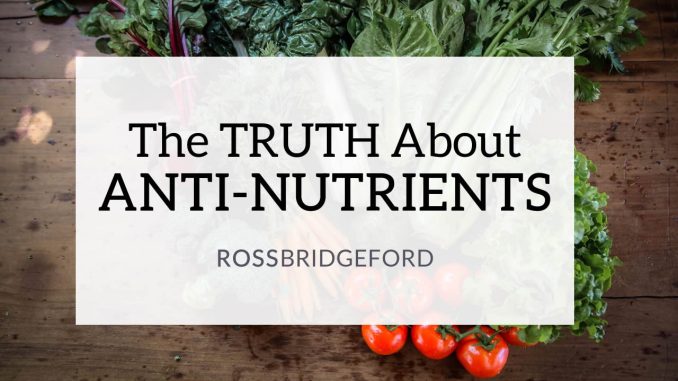
In the expansive and often bewildering world of nutrition, where superfoods are lauded and dietary villains are demonized, a lesser-known but equally significant concept often operates beneath the radar: anti-nutrients. For many, the very term might sound alarming, conjuring images of harmful compounds that negate the goodness of otherwise healthy foods. While anti-nutrients can indeed interfere with the absorption of essential vitamins, minerals, and other beneficial compounds, a nuanced understanding reveals that they are rarely a cause for alarm for most individuals consuming a balanced diet. Instead, they represent another fascinating layer in the complex tapestry of food science, offering opportunities to optimize nutrient absorption through simple culinary techniques.
At their core, anti-nutrients are natural compounds found in a wide variety of plant-based foods, and to a lesser extent, in some animal products. They evolved as protective mechanisms for plants, deterring pests and pathogens, and aiding in their survival. From a human dietary perspective, their “anti-nutrient” label stems from their ability to bind with certain nutrients, making them less bioavailable, or to inhibit the activity of digestive enzymes. However, it’s crucial to understand that their effects are dose-dependent, and for most people, a diet rich in whole, unprocessed foods, even those containing anti-nutrients, remains overwhelmingly beneficial.
Let’s explore some of the most common anti-nutrients and their implications.
**Phytates**, or phytic acid, are widely found in whole grains, legumes (like beans, lentils, and chickpeas), nuts, and seeds. Their primary concern is their ability to bind with minerals such as iron, zinc, calcium, and magnesium, forming insoluble complexes that the body cannot easily absorb. This has led to some concern, particularly in populations heavily reliant on unrefined cereals and legumes for their staple diet. However, for those consuming a varied diet, the impact is generally minimal. Furthermore, traditional preparation methods like soaking, sprouting, and fermentation significantly reduce phytate levels. For example, soaking beans overnight before cooking, or fermenting sourdough bread, can dramatically improve mineral bioavailability.
**Lectins** are proteins found in many plant foods, notably legumes, whole grains (especially wheat), and nightshade vegetables like tomatoes, potatoes, and bell peppers. Some lectins, particularly in their raw state, can cause digestive distress, nutrient malabsorption, and potentially even damage the gut lining in susceptible individuals. The most well-known example is phytohaemagglutinin in raw kidney beans, which can be quite toxic. However, just like phytates, lectins are largely denatured and rendered harmless by proper cooking methods, particularly boiling and soaking. The pressure cooking of legumes, for instance, effectively neutralizes lectins. For most people, the health benefits of consuming these nutrient-rich foods far outweigh any potential lectin-related risks, especially when prepared correctly.
**Oxalates**, or oxalic acid, are present in many plant foods, including leafy greens (like spinach and kale), rhubarb, berries, nuts, and chocolate. Their primary concern is their ability to bind with calcium, potentially forming calcium oxalate crystals, which can contribute to kidney stones in predisposed individuals. For most people, a balanced diet that includes oxalate-rich foods is perfectly healthy, especially if adequate calcium intake is maintained. Cooking methods like boiling can reduce oxalate content, as oxalates can leach into the cooking water. Combining oxalate-rich foods with calcium-rich foods can also help, as the oxalate will bind to calcium in the digestive tract before it can be absorbed by the body.
**Tannins** are polyphenols found in teas, coffee, grapes, and some legumes. They are responsible for the astringent taste in many of these foods. Tannins can interfere with the absorption of iron, particularly non-heme iron (the type found in plants). This is why it’s often recommended to avoid drinking tea or coffee immediately after an iron-rich meal, especially for individuals at risk of iron deficiency. However, tannins also possess beneficial antioxidant properties, highlighting the complex nature of these compounds.
**Saponins** are compounds found in quinoa, legumes, and some herbs. They can create a soapy foam when mixed with water. While they can sometimes cause minor digestive upset and theoretically interfere with nutrient absorption, rinsing and soaking quinoa, for instance, largely removes them. Interestingly, research also suggests saponins may have some health benefits, including cholesterol-lowering properties.
The overarching truth about anti-nutrients is that they are generally only a concern in extreme dietary scenarios, such as when one’s diet is overwhelmingly dominated by unsoaked, uncooked, or unprocessed sources of these compounds, or in individuals with pre-existing nutrient deficiencies or certain medical conditions. For the vast majority of people following a varied, whole-food diet, the benefits of consuming fruits, vegetables, grains, and legumes—packed with fiber, vitamins, minerals, and antioxidants—far outweigh the minimal interference from anti-nutrients.
Moreover, many traditional culinary practices have implicitly (and effectively) dealt with anti-nutrients for centuries. Soaking, sprouting, fermenting, and thorough cooking are not just about improving palatability; they are powerful techniques for reducing anti-nutrient content and enhancing nutrient bioavailability. Embracing these simple kitchen methods allows us to unlock the full nutritional potential of our plant-based foods.
In conclusion, while the term “anti-nutrient” might initially sound alarming, a deeper understanding reveals them to be a natural part of our food ecosystem. They highlight the intricate balance within plants and the adaptive ways in which humans have learned to prepare and consume them. Instead of fearing these compounds, we can view them as an opportunity to optimize our diet through traditional cooking techniques and by ensuring a diverse intake of nutritious foods. For most healthy individuals, the focus should remain on consuming a wide variety of whole, unprocessed foods, confident that the immense benefits they offer far eclipse any minor interference from anti-nutrients.